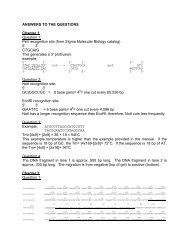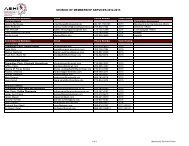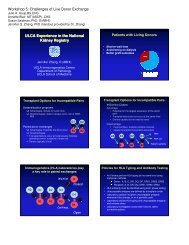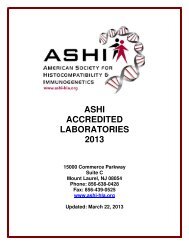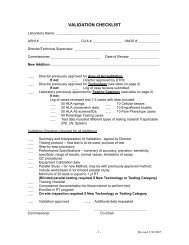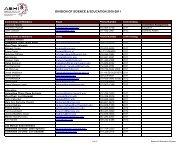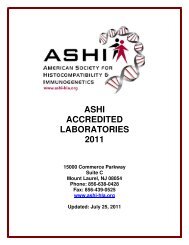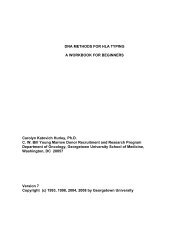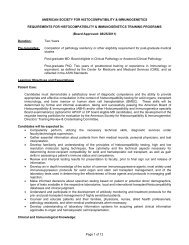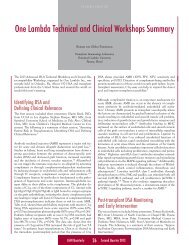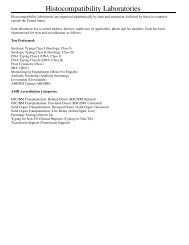15-PSOLID PHASE ANTIBODY (SpA) IDENTIFICATION: EFFECT OF INTERFERINGSUBSTANCES OR PROZONE PHENOMENON.Manish J. Gandhi, Nancy A. Ploeger, Deborah K. Falbo, Steven R. DeGoey. Division of TransfusionMedicine, Mayo Clinic, Rochester, MN, USA.Aim: HLA antibodies (HLA-Abs), especially donor specific antibodies (DSA) identified by SpA are usedpre-transplant (Tx) to screen donors and <strong>for</strong> post Tx monitoring. However, there are questions regarding itstechnical limitation.Methods: Results from 11 recipients with low to high levels of HLA-Abs were compared after per<strong>for</strong>mingSpA by: 1.manufacturer protocol 2.after treatment at 56C <strong>for</strong> 30 minutes (inactivate complement) 3.aftertreatment at 63C <strong>for</strong> 13 minutes (inactivate IgM) 4.after 1:8 dilution.Results: Heat treatment resulted in increased mean flouresence intensity (MFI) of the negative control beadas shown below:[table1]Heat treatment resulted in increased number of allele specificities with MFI >5<strong>00</strong>:untreated=626, 56C=702, 63C=661, diluted=633. However, dilution demonstrated higher number of allelespecificities with MFI >6<strong>00</strong>0 as shown below:[table2]Significantly, <strong>for</strong> BP and WK, untreated DSA MFIwas 50,<strong>00</strong>0 and correlated with B-flow crossmatchchannel shift >5<strong>00</strong>.Conclusions: HLA-Abs detection by SpA can be effected by the steric interference from complement orIgM. Heat treating the sample helps however, there is increased background. Some cases with high level ofantibodies also demonstrate a prozone phenomenon as demonstrated by significantly higher number ofalleles with MFI >6<strong>00</strong>0.16-PGOOD ANTIBODY OR BAD ANTIBODY?Ralph Graff, Huiling Xiao, Mark Schnitzler, Janet Tuttle-Newhall, Krista Lentine. Saint Louis University,St. Louis, MO, USA.Aim: We examined national registry data to characterize the associations of complement-dependentcytotoxicity crossmatch (CDCXM) results with graft survival among transplants per<strong>for</strong>med incontemporary practice.Methods: OPTN registry data <strong>for</strong> deceased-donor (DD) and live donor (LD) kidney transplants per<strong>for</strong>medafter CDCXM testing in 1995-2<strong>00</strong>9 were examined. We estimated the association of CDCXM results (+ vs-) with allograft survival over 5 yrs result by the Kaplan-Meier method in the full samples and indemographic and clinical subgroups.Results: Among 24,607 and 32,<strong>27</strong>9 LD and DD transplants per<strong>for</strong>med after CDCXM testing, 1155 DD and1019 LD recipients received CDCXM+ transplants in the study period. Overall, compared to CDCXMtransplants,CDCXM+ was associated with absolute reductions in 1yr LD and DD graft survival of 2.2%and 3.8%, respectively (p50%), white or 18-64 yo.Notably, CDCXM+ vs CDCXM- was not associated with increased risk of graft loss in re-transplants or inblack, 64 yr old recipients (Table 1).[figure1]Conclusions: Among transplants per<strong>for</strong>med in contemporary practice, the benefit of avoiding CDCXM+appears to be an 2-4% absolute benefit in 5yr graft survival. Given the moderate magnitude of risk,mitigating factors that resulted in the decision to transplant despite CDCXM+ were well-considered. Thesedata support that CDCXM+ should not be considered a universal contraindication to transplantation.17-PSINGLE ANTIGEN ANTIBODY ASSAY RUN TO RUN VARIATION: HOW QUANTITATIVEARE WE REALLY?Anne Halpin, Megan Brown, Luis Hidalgo, Patricia Campbell. Histocompatibility Laboratory, Universityof Alberta Hospital, Alberta Health Services, Edmonton, AB, Canada.Aim: Our aim is to evaluate the run to run variation of our single antigen antibody assay. The antibody(Ab) strength is measured by the median fluorescence intensity (MFI) <strong>for</strong> a given antigen. A secondary
goal is to re-examine our previous findings that the vaccum wash (VW) method is at least as effective asthe centrifugation wash (CW) method.Methods: We tested 10 sera with multiple Ab (5 Class I and 5 Class II) using LabScreen® Single Antigenbeads (LS1A04 and LS2A01, One Lambda Inc.); beads will be referred to as LSA1 (class I) and LSA2(class II). Sera were tested as per product insert using VW and the CW with dry vortex methods. Most serawere tested twice by each VW and CW but 3 were tested once by VW. Two lot# of LSA2 beads were usedbetween wash techniques thus these results are limited to INTRA-method comparison. Raw data wereexported to Excel and analysed.Results: There is variability within VW and CW runs as measured by the mean delta value of the MFIdifference. There is less variation in the VW runs than the CW. The mean baseline MFI to known donorantigens in LSA1 (7 Ab) is higher in the VW method than the CW method (57<strong>00</strong> vs 4131 MFI). Althoughthe beads appeared in the same order in almost every case, the MFI of most Ab were higher in the FWresults. The LSA1 mean NC value is 97 vs 37 and the mean PC value is 6690 vs 4709 <strong>for</strong> the VW and CWrespectively. The LSA2 mean NC value is 117 vs 25 and the mean PC value is 6368 vs 4585 <strong>for</strong> the VWand CW respectively. The VW method saves at least 30 minutes of bench time and eliminates the risk ofcreating biohazardous aerosols.Conclusions: Regardless of wash technique used, there is clear run to run variation, especially <strong>for</strong> strongantibodies. For this reason, we will continue our practice of re-testing a previously tested serum in parallelwith new sera samples <strong>for</strong> patients being monitored <strong>for</strong> Ab strength. We will continue to use the filter platewash method.18-PAN HLA-DP ANTIBODY DILEMMA – CASE STUDY.Jean L. Heneghan, Karen A. Sullivan. Medicine, Tulane University, New Orleans, LA, USA.Aim: In an on-going ef<strong>for</strong>t to improve our ability to per<strong>for</strong>m virtual crossmatching, we retrospectivelyinvestigate all positive donor crossmatches. While our prediction rate has improved over the years due toimproved methodology, there are still some cases which will require adding HLA-DP results to the UNOSdatabase system.Methods: FT is a 32BM who received a 0 Ag MM DCD kidney in 2<strong>00</strong>1. It failed in 2<strong>00</strong>3 likely due toFSGF. No donor-specific HLA Ab was detected post transplant by ELISA methodology. However, FT wassensitized to other HLA antigens due to blood transfusions. FT was re-wait listed. He soon received another0 Ag MM DCD kidney offer. He was not transplanted due to positive flow B cell crossmatches. The patientand donor were typed <strong>for</strong> HLA-DP antigens using SSO methodology. Detection of HLA-DP antibodies wasper<strong>for</strong>med using LUMINEX.Results: Retrospective studies indicated the crossmatches were likely positive due to donor-specific HLA-DP antibody. FT has received several additional well matched kidney offers. Each respective donor B cellflow crossmatch was positive, and antibody to donor-specific HLA-DP antigens determined to be the likelycause. In each case FT was not transplanted, as our program does not usually transplant across a positivecrossmatch which is likely due to any donor-specific HLA antibody.Conclusions: Until HLA-DP typing results and unacceptable antigens (and Cw antigens as well) can beadded to the UNOS patient database and become incorporated into the match algorhythm, patients andtransplant programs will continue to incur the unnecessary travel, expense and time of bringing in thesepatients <strong>for</strong> final crossmatching. Perhaps if HLA-DP results were incorporated into the UNOS system,global data analysis could answer the question of whether such antibodies are even a contraindication totransplantation.19-PHLA ANTIBODY IDENTIFICATION USING LUMINEX-BASED ASSAYS – ARE WE ON THESAME PAGE? THE MICHIGAN EXPERIENCE.Chak-Sum Ho 1 , Mary A. Jackowski 1 , Dorothy Levis 1 , Omar R. Fagoaga 2 , John A. Gerlach 3 , MalekKamoun 4 , Gabriel N. Maine 5 , Jerry C. Rosenberg 1 , A. Bradley Eisenbrey 1,6 . 1 Gift of Life Michigan, AnnArbor, MI, USA; 2 Detroit Medical Center, Detroit, MI, USA; 3 Michigan State University, East Lansing, MI,USA; 4 University of Michigan, Ann Arbor, MI, USA; 5 William Beaumont Hospital, Royal Oak, MI, USA;6 Henry Ford Hospital, Detroit, MI, USA.
- Page 1 and 2: Monday, September 27, 20102:00 PM -
- Page 3 and 4: 5-ORTWO CASES OF DONOR SPECIFIC ANT
- Page 5 and 6: Monday, September 27, 20102:00 PM -
- Page 7 and 8: Results: PHA-induced mRNA expressio
- Page 9 and 10: conjugated IgM (BD Biosciences), Ig
- Page 11 and 12: Methods: Peripheral blood and endom
- Page 13 and 14: Aim: NK cells have an established r
- Page 15 and 16: Methods: Sera (n=22) were tested fo
- Page 17 and 18: expression on lymphocytes, we hypot
- Page 19: Conclusions: Clean SA beads can eli
- Page 23 and 24: Aim: There is increasing evidence t
- Page 25 and 26: esult in poor graft survival. The g
- Page 27 and 28: Aim: Pronase treatment eliminates i
- Page 29 and 30: 34-PCLINICAL AND PATHOLOGICAL SIGNI
- Page 31 and 32: Nabil Mohsin, Isabelle G. Wood, Ind
- Page 33 and 34: donor/recipient pairs for transplan
- Page 35 and 36: and tested in the DynaChip assay fo
- Page 37 and 38: average difference between Ave and
- Page 39 and 40: Conclusions: The XM-One assay can b
- Page 41 and 42: 59-PCYTOTOXIC AND NON-CYTOTOXIC ANT
- Page 43 and 44: data suggests that DTT pretreatment
- Page 45 and 46: Bhavna Lavingia 1 , Chantale Lacell
- Page 47 and 48: ATG INTERFERNCE IN SINGLE ANTIGEN L
- Page 49 and 50: 75-PPREFORMED LOW REACTIVE ANTI-HLA
- Page 51 and 52: Sabarinathan Ramachandran 1 , Naohi
- Page 53 and 54: 83-PALLELIC DIVERSITY OF KIR2DL4 AN
- Page 55 and 56: São Paulo, Brazil; 3 Commissariat
- Page 57 and 58: 91-PCHARACTERIZATION OF COMMON AND
- Page 59 and 60: Conclusions: The extensive diversit
- Page 61 and 62: 99-PPOTENTIAL COMMON NOVEL ALLELES
- Page 63 and 64: 103-PTOWARDS A FUNCTIONAL HLA-DPB1
- Page 65 and 66: 107-PWHOLE GENOME AMPLIFICATION (WG
- Page 67 and 68: 111-PLOSS OF MISMATCHED HLA IN FAMI
- Page 69 and 70: 115-PDONOR EPITHELIAL CELL CHIMERIS
- Page 71 and 72:
Caucasian patients. MRs vary signif
- Page 73 and 74:
Results: We obtained the total No.
- Page 75 and 76:
cord blood and platelet transfusion
- Page 77 and 78:
131-PASSOCIATION OF IL-2-330(G/T) W
- Page 79 and 80:
Institute, Children’s Hospital Oa
- Page 81 and 82:
Methods: To prove the robustness of
- Page 83 and 84:
populations.We studied the involvem
- Page 85 and 86:
amplicons generated from different
- Page 87 and 88:
Results: The sequence of the unexpe
- Page 89 and 90:
concentration of the Taq Polymerase
- Page 91 and 92:
160-PASSOCIATION OF HAPLOTYPES WITH
- Page 93 and 94:
164-PDETECTION OF A DE NOVO DONOR S
- Page 95 and 96:
168-PA NOVEL HLA-DQB1 ALLELE CONFIR
- Page 97 and 98:
172-PSCREENING FOR HLA-SPECIFIC ALL
- Page 99 and 100:
176-PIMPLEMENTATION OF THE WORLD HE
- Page 101 and 102:
epertoire of displayed ligands and
- Page 103 and 104:
mucosa. No other samples were avail
- Page 105 and 106:
Conclusions: In previously reported
- Page 107 and 108:
Conclusions: Our findings can demon
- Page 109 and 110:
Conclusions: In analyzing this data
- Page 111 and 112:
examined on microarrays from a huma
- Page 113 and 114:
Methods: Serial analysis of sera ob
- Page 115 and 116:
Conclusions: These new technologies
- Page 117 and 118:
allograft injury. Four of these 18
- Page 119 and 120:
A NOVEL HLA CLASS I SINGLE ANTIGEN
- Page 121 and 122:
Results: Approximately twice as man
- Page 123:
Methods: Molecular HLA typing was p



